Navigation
Food Force: The First Humanitarian Video Game Updated and Free to Download
- Agriculture
- agriculture
- emergency response
- food security analysis
- games
- hunger
- Internet
- malnutrition
- nutrition
- procurement
- technology
- UN
- undernutrition
- World Food Programme
- Desertification
- Global Climate Change
- Natural Disaster Relief
- Pollution
- Population
- Public Health
- Sanitation
- Water
- Water and Sanitation
The World Food Program’s (WPG’s) video game Food Force invites children, and people of all ages, to complete six virtual missions that reflect real-life obstacles faced by WFP in its emergency responses both to the tsunami and other hunger crises around the world.
The Hunger Games Cast Teams up to End Hunger
By World Food Program (WPG)
Since its release in 2005, the World Food Program’s (WPG’s) video game to teach children, and people of all ages, about the logistical challenges of delivering food aid in a major humanitarian crisis has been downloaded over 6 million times, and has an estimated network of 10 million players worldwide!
Set on a fictitious island called Sheylan riven by drought and war, Food Force invites children, and people of all ages, to complete six virtual missions that reflect real-life obstacles faced by WFP in its emergency responses both to the tsunami and other hunger crises around the world.
With tens of thousands of Sheylan’s residents displaced and in urgent need of food aid, players are required to pilot helicopters on reconnaissance missions, airdrop high energy biscuits to internally displaced person (IDP) camps, negotiate with armed rebels on a food convoy run and use food aid to help rebuild villages.
You can download the free game here:
http://www.wfp.org/how-to-help/individuals/food-force
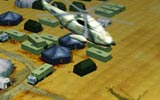 "Communicating with children today means using the latest technology," said Neil Gallagher, WFP’s Director of CommunicationsLatest Technology
"Communicating with children today means using the latest technology," said Neil Gallagher, WFP’s Director of CommunicationsLatest Technology
"Communicating with children today means using the latest technology," said Neil Gallagher, WFP’s Director of Communications, speaking on the day the game was unveiled at the International Children’s Book Fair in Bologna, Italy.
“We believe that Food Force will generate kids’ interest and understanding about hunger, which kills more people than AIDS, malaria and tuberculosis combined.”
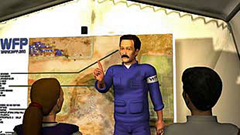 Virtual Aid Workers undertake missions to relieve hunger.Virtual Aid Workers
Virtual Aid Workers undertake missions to relieve hunger.Virtual Aid Workers
To underline the game’s main objectives of teaching children about global hunger and WFP’s efforts to fight it, each mission begins with a briefing on the task ahead by a member of the Food Force team of virtual aid workers.
It is followed by feedback on the player’s performance and an educational video filmed on the frontlines of WFP’s work in the field.
Food Force: the Missions
Mission One is all about hunger assessment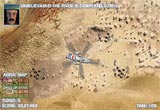 Hunger Assessment. The island of Sheylan is suffering the effects of drought and civil war, and the player must take to the air to evaluate how many people need feeding and the quickest way to get food to them -- just as WFP initially used air surveillance in the wake of the Indian Ocean tsunami.
Hunger Assessment. The island of Sheylan is suffering the effects of drought and civil war, and the player must take to the air to evaluate how many people need feeding and the quickest way to get food to them -- just as WFP initially used air surveillance in the wake of the Indian Ocean tsunami.
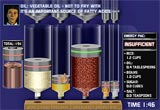 Players are challenged to combine essential commodities to create a balanced and nutritious diet.Mission Two focuses on WFP’s efforts to find a balance between nutritional needs, local diet and total cost when designing its food rations. Players are challenged to combine essential commodities such as rice, beans, vegetable oil and sugar to create a balanced and nutritious diet for Sheylan’s inhabitants, on a budget of just 30 US cents per person per meal.
Players are challenged to combine essential commodities to create a balanced and nutritious diet.Mission Two focuses on WFP’s efforts to find a balance between nutritional needs, local diet and total cost when designing its food rations. Players are challenged to combine essential commodities such as rice, beans, vegetable oil and sugar to create a balanced and nutritious diet for Sheylan’s inhabitants, on a budget of just 30 US cents per person per meal.
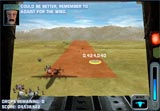 Player work on ability to airdrop food.Mission Three tests the player’s ability to airdrop food to communities on Sheylan isolated by war and/or geography without endangering lives. WFP frequently uses airdrops to reach Sudanese IDP's cut off by the rainy season or fighting.
Player work on ability to airdrop food.Mission Three tests the player’s ability to airdrop food to communities on Sheylan isolated by war and/or geography without endangering lives. WFP frequently uses airdrops to reach Sudanese IDP's cut off by the rainy season or fighting.
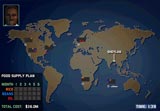 Buying the food.Mission Four focuses on the vital, first step in delivering food aid: buying the food. Players must calculate how and where to purchase food in order to satisfy Sheylan’s immediate and longer-term needs during the six months following the emergency.
Buying the food.Mission Four focuses on the vital, first step in delivering food aid: buying the food. Players must calculate how and where to purchase food in order to satisfy Sheylan’s immediate and longer-term needs during the six months following the emergency.
 Ensuring the safe arrival of a convoy of food trucks.Mission Five is concerned with a key link in the WFP food supply chain that stretches from donor nations via planes, lorries and ships to the mouths of the hungry. The player is responsible for ensuring the safe arrival of a convoy of food trucks, and, like WFP trucks in the field, must negotiate obstacles including land mines, fallen bridges and local rebel forces.
Ensuring the safe arrival of a convoy of food trucks.Mission Five is concerned with a key link in the WFP food supply chain that stretches from donor nations via planes, lorries and ships to the mouths of the hungry. The player is responsible for ensuring the safe arrival of a convoy of food trucks, and, like WFP trucks in the field, must negotiate obstacles including land mines, fallen bridges and local rebel forces.
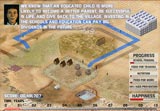 Long-term development challenges.Mission Six deals with the longer-term development challenges which follow an emergency, when the hungry and homeless must rebuild their lives and communities.
Long-term development challenges.Mission Six deals with the longer-term development challenges which follow an emergency, when the hungry and homeless must rebuild their lives and communities.
The Food Force site also includes more information about WFP and features a special section for teachers with downloadable lesson plans on what hunger is, why it exists and how to end it. A How to Help section provides ideas on fundraising and school involvement.
“Food Force is a game that parents will encourage their children to play at home and that teachers will find stimulating to use in the classroom,” said Gallagher.
"So many parents complain about the blood and gratuitous violence that kids are so frequently exposed to in video games, this is a fun and action packed alternative."
This information and all images and the video are from World Food Program’s (WPG’s) at http://www.wfp.org/how-to-help/individuals/food-force.
Notes:
Background on the first version of Food Force game can be read on the Horizon International Solutions Site at http://www.solutions-site.org/node/203
Related Book with accompanying DVDs:
In the Introduction to his chapter “Malnutrition and Undernutrition” in a new book, Water and Sanitation Related Diseases and the Environment: Challenges, Interventions and Preventive Measures, Dr. Jeffrey K. Griffiths, writes: “Malnutrition and undernutrition remain prominent global causes of ill health and premature mortality. These conditions contribute to high rates of mortality in children under the age of 5 and in pregnant women, as well as to morbidity in many age ranges. A recent estimate is that malnutrition contributes to the death of one-third of all children under the age of 5. Malnutrition can kill directly, as in famine, and also indirectly, by increasing both the rate and severity of infectious diseases. Above and beyond these medical outcomes, malnutrition and undernutrition contribute to lower educational productivity, and to lower social achievement and earning power.”
Jeffrey K. Griffiths, MD MPH&TM, is Director, Nutrition Collaborative Research Support Program for Africa, Chair, Drinking Water Committee, US EPA Science Advisory Board, Professor of Public Health, and Director, Global Health, Department of Public Health and Community Medicine, Tufts University Schools of Medicine, Nutrition, Veterinary Medicine and Engineering
Read more about the book, a Wiley-Blackwell collaboration with Horizon International, on the Horizon Solutions Site at http://www.solutions-site.org/node/532.
Search
Latest articles
Agriculture
- World Water Week: Healthy ecosystems essential to human health: from coronavirus to malnutrition Online session Wednesday 24 August 17:00-18:20
- World Water Week: Healthy ecosystems essential to human health: from coronavirus to malnutrition Online session Wednesday 24 August 17:00-18:20
Air Pollution
- "Water and Sanitation-Related Diseases and the Changing Environment: Challenges, Interventions, and Preventive Measures" Volume 2 Is Now Available
- Global Innovation Exchange Co-Created by Horizon International, USAID, Bill and Melinda Gates Foundation and Others
Biodiversity
- It is time for international mobilization against climate change
- World Water Week: Healthy ecosystems essential to human health: from coronavirus to malnutrition Online session Wednesday 24 August 17:00-18:20
Desertification
- World Water Week: Healthy ecosystems essential to human health: from coronavirus to malnutrition Online session Wednesday 24 August 17:00-18:20
- UN Food Systems Summit Receives Over 1,200 Ideas to Help Meet Sustainable Development Goals
Endangered Species
- Mangrove Action Project Collaborates to Restore and Preserve Mangrove Ecosystems
- Coral Research in Palau offers a “Glimmer of Hope”
Energy
- Global Innovation Exchange Co-Created by Horizon International, USAID, Bill and Melinda Gates Foundation and Others
- Wildlife Preservation in Southeast Nova Scotia
Exhibits
- Global Innovation Exchange Co-Created by Horizon International, USAID, Bill and Melinda Gates Foundation and Others
- Coral Reefs
Forests
- NASA Satellites Reveal Major Shifts in Global Freshwater Updated June 2020
- Global Innovation Exchange Co-Created by Horizon International, USAID, Bill and Melinda Gates Foundation and Others
Global Climate Change
- It is time for international mobilization against climate change
- It is time for international mobilization against climate change
Global Health
- World Water Week: Healthy ecosystems essential to human health: from coronavirus to malnutrition Online session Wednesday 24 August 17:00-18:20
- More than 400 schoolgirls, family and teachers rescued from Afghanistan by small coalition
Industry
- "Water and Sanitation-Related Diseases and the Changing Environment: Challenges, Interventions, and Preventive Measures" Volume 2 Is Now Available
- Global Innovation Exchange Co-Created by Horizon International, USAID, Bill and Melinda Gates Foundation and Others
Natural Disaster Relief
- STOP ATTACKS ON HEALTH CARE IN UKRAINE
- Global Innovation Exchange Co-Created by Horizon International, USAID, Bill and Melinda Gates Foundation and Others
News and Special Reports
- World Water Week: Healthy ecosystems essential to human health: from coronavirus to malnutrition Online session Wednesday 24 August 17:00-18:20
- STOP ATTACKS ON HEALTH CARE IN UKRAINE
Oceans, Coral Reefs
- World Water Week: Healthy ecosystems essential to human health: from coronavirus to malnutrition Online session Wednesday 24 August 17:00-18:20
- Mangrove Action Project Collaborates to Restore and Preserve Mangrove Ecosystems
Pollution
- Zakaria Ouedraogo of Burkina Faso Produces Film “Nzoue Fiyen: Water Not Drinkable”
- "Water and Sanitation-Related Diseases and the Changing Environment: Challenges, Interventions, and Preventive Measures" Volume 2 Is Now Available
Population
- "Water and Sanitation-Related Diseases and the Changing Environment: Challenges, Interventions, and Preventive Measures" Volume 2 Is Now Available
- "Water and Sanitation-Related Diseases and the Changing Environment: Challenges, Interventions, and Preventive Measures" Volume 2 Is Now Available
Public Health
- Honouring the visionary behind India’s sanitation revolution
- Honouring the visionary behind India’s sanitation revolution
Rivers
- World Water Week: Healthy ecosystems essential to human health: from coronavirus to malnutrition Online session Wednesday 24 August 17:00-18:20
- Mangrove Action Project Collaborates to Restore and Preserve Mangrove Ecosystems
Sanitation
- Honouring the visionary behind India’s sanitation revolution
- Honouring the visionary behind India’s sanitation revolution
Toxic Chemicals
- "Water and Sanitation-Related Diseases and the Changing Environment: Challenges, Interventions, and Preventive Measures" Volume 2 Is Now Available
- Actions to Prevent Polluted Drinking Water in the United States
Transportation
- "Water and Sanitation-Related Diseases and the Changing Environment: Challenges, Interventions, and Preventive Measures" Volume 2 Is Now Available
- Urbanization Provides Opportunities for Transition to a Green Economy, Says New Report
Waste Management
- Honouring the visionary behind India’s sanitation revolution
- Honouring the visionary behind India’s sanitation revolution
Water
- Honouring the visionary behind India’s sanitation revolution
- Honouring the visionary behind India’s sanitation revolution
Water and Sanitation
- Honouring the visionary behind India’s sanitation revolution
- Honouring the visionary behind India’s sanitation revolution

